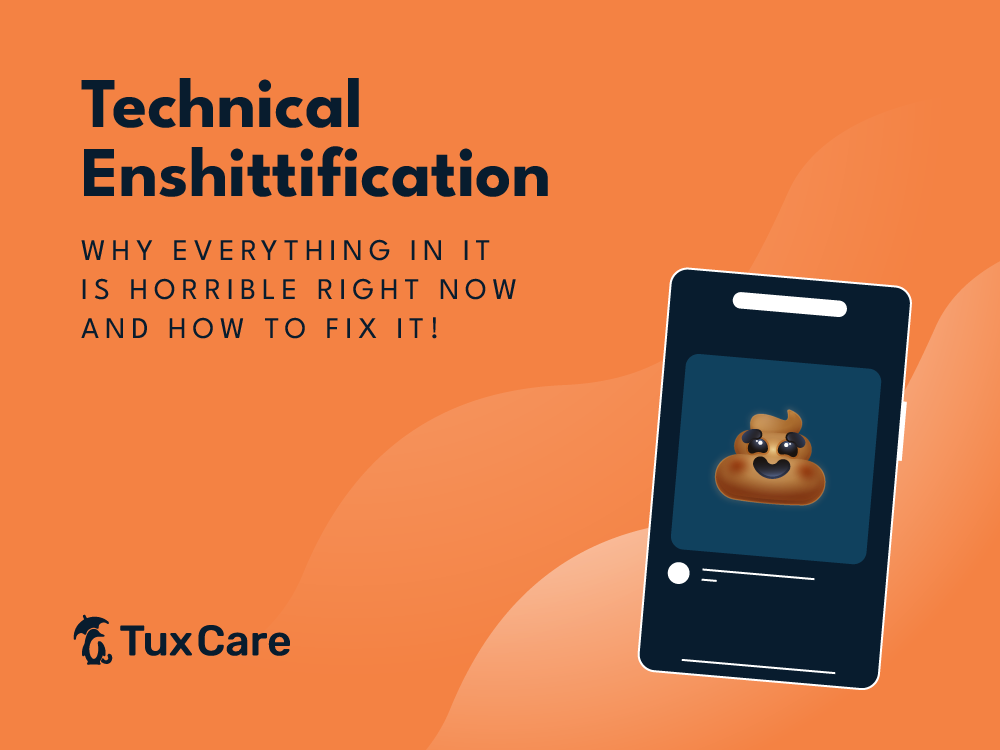Digital platforms we use today are infected with creeping awfulness, and Cory Doctorow has given it a name – Enshittification. Have you ever felt like an online platform is giving you value just to lock you in and degrade the experience in favor of monetization and control? Well, that’s the essence of enshittification.
This article sheds light on how platforms gather users by providing value, lock them in, then stop providing value and start selling users. Everyone feels this on social media platforms, but have you ever thought about what happens when this principle transcends social media and is applied to foundations of modern IT?
That’s where technical enshittification comes in. It’s the idea that software, systems, and services aren’t built for users, but for the incentives of executives, deadlines, and marketing gimmicks. What does the user get? A bloated, bizarre, and broken solution.
Take major platforms like the Facebook app or Chrome, for example. One got so large in size because of bloated features that the company had to release a second mini-app – and the other? Well, it eats up RAM like an operating system. These aren’t standalone cases. They are symptoms of the ideation and development of modern software.
What can we do about technical enshittification? Let’s find out!
Big Tech’s One Broken Promise after Another!
Before we get into the solution for technical enshittification, let’s look at what big tech is doing for innovation. These companies continue to equate progress and innovation with shallow upgrades and trendy AI features. Improving core functionalities that actually add value to user’s experience.., well, that’s just big “No.”
Back in September 2023, Amazon promised a major AI upgrade for Alexa, making the assistant smarter and more responsive. Two and half years later…? It still remains a promise despite all the hardware, infrastructure, and servers the organization has. Google is no different. Users kept staring at a “new look is coming soon” message for months!
The end result was minor interface tweaks that changed nothing. We’re being sold cosmetic updates labeled as meaningful progress. Operating systems aren’t an exception here. Apple’s Dynamic Island iOS was supposed to be the most notable upgrade, but the end result was the same.
And Windows? There are differences between Windows 10 and 11, but it’s all interface and visuals. Companies aren’t addressing user needs. They’re just slapping on trendy AI features or making TikTok-like design changes. What’s next? A banking app with a “Stories” feature?
Today, innovation has shifted from what’s actually being developed to companies repackaging stagnation as progress using fancy visuals!
The Sonos Failure Case Study
When it comes to technical enshittification, the Sonos app launch is the perfect example. The company rolled out a completely new app design, but ignored the entire user base altogether. Within days the app got around 200,000 reviews and 1.2 start rating. What was the problem?
Well, the backlash wasn’t about the design. It was about the fact that critical features like a sleep timer, music library, and playlist were all missing at launch. And guess what? Sonos is a music management app! It was supposed to have all of this, but it didn’t. The reason is simple – technical enshittification facilitating the management.
A whistleblower later revealed that the company had ignored internal warnings, the management forced a rigid deadline knowing the app wasn’t ready, and, the worst part – team reorganization. The management thought it would be wise to split people who have been working together creating great apps for years into different groups.
The key takeaway here is that optics combined with managerial innovation and both of them prioritized over functionality is a combination for disaster and a textbook example of technical enshittification.
Factors Contributing to Technical Enshittification
Technical enshittification isn’t just a standalone phenomenon. It’s gaining contributions from all sides. Understanding all the different factors that are now leading to the enshittification of modern software and systems is essential when determining what can be done about it. These factors include:
-
Technical Enshittification – Bloat Is Now a Feature
Joseph Stalin might have said that “Quantity has a quality of its own,” and it might have been true in his time, but in today’s software industry, that’s not the case. More quantity destroys quality, but companies keep bloating their apps and software like it’s a feature.
Take one look at the complex stack modern apps are built on and you’ll see the full picture! An app that opens a garage door takes up 50 million lines of code, and its functionalities are spread across the app, cloud services, virtual machines, and multiple OS layers. Such a stack doesn’t just increase inefficiency, it also increases security risk because threat actors have a larger attack surface and potentially more vulnerabilities to target.
Examples of technical enshittification through bloating can be found in basic apps as well. Sumatra PDF, a simple, lightweight reader, is 16 MB and gets the job done. Adobe Acrobat? Same task, but it needs 1 GB of disk space and 2 GB of RAM. Chrome and its entire ecosystem are no different, and bloating itself isn’t just unsustainable, it’s the source of technical debt.
-
The Illusion of Productivity
Many people expect developers to spend days writing their code. But the reality is far different and far more grim. Studies have shown that the median coding time for a developer is under one hour in an entire working day.
These professionals aren’t lazy, they’re just bombarded with distractions that come from a broken system. Context switching, checking emails, Slack pings, meetings, task updates, and 25-minute refocus sessions after every interruption are common examples.
All of them add up to reduce productivity and lead to greater technical enshittification. What this means is individual performance isn’t the issue. It’s structural inefficiency that makes the developer too busy to code.
-
Technical Debt Crushing Innovation
Technical debt and technical enshittification go hand in hand. Let’s circle back to Sonos. The app’s failure wasn’t just because of timing and tight deadlines. It had years and years of technical debt that kept innovation from prevailing.
The fact that technical debt stalls progress and innovation isn’t just an isolated issue. Studies show that 80% of developers believe technical debt is what keeps them from innovation during development.
-
AI Is the Fuel for the Fire
AI tools can speed up the development process, but if the process and development itself is just fire waiting to cause damage, speeding it up isn’t going to do anyone any favors. Studies have shown that AI generated code can be incorrect up to 65% of the time.
AI was supposed to help make things better, but, in reality, it has introduced a new kind of technical debt that developers have to manage. To use AI effectively, developers need to pair the code generation platform with quality enforcement layers like Junie and Qodo. This can be effective, but it adds another layer to the tech stack.
Dealing with Technical Enshittification
Now that we’ve got a firm grip of what technical enshittification is, let’s look at how we can deal with it. First and foremost, remember that dealing with technical enshittification requires you to take deliberate action. Some of the key steps that can be taken to deal with this are:
- Speed up feedback loops because the faster you know something is broken, the faster you can fix it. Remember that delays between bug reports and a fix being applied only increase the cost of recovery and chances of enshittification.
- Identify repetitive tasks that can be automated, since having developers spend time on such things lowers both their productivity and ability to innovate.
- Limit developer distractions by using tools that block out unnecessary notifications so that developers can have better focus during their deep work hours.
- Ensure constant refactoring, as it makes system maintenance more efficient, reduces technical debts, and makes way for innovation.
- Be more agile by making decisions when information is available, as opposed to sticking to a plan only because one exists.
- Communicate effectively by translating tech-related concerns and feedback into language that expresses business value.
Final Thoughts
Today, technical enshittification has become a leading flaw in modern IT, meaning that the solutions users get are more of frustration than an actual solution. This happens because of a number of different reasons like bloating, misconfigured security policies, inefficient AI use, misaligned incentives, and more – but it doesn’t have to stay that way.
Restoring quality practices back to engineers and developers, focusing on reducing technical debt, giving priority to utilization and functionality as opposed to trendy visuals during development, communicating tech as business value are all examples of initiative that can help limit technical enshittification and restore quality in IT.



 Documentation
Documentation Login
Login





